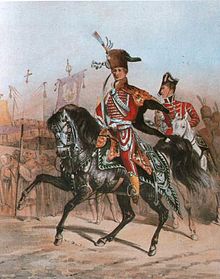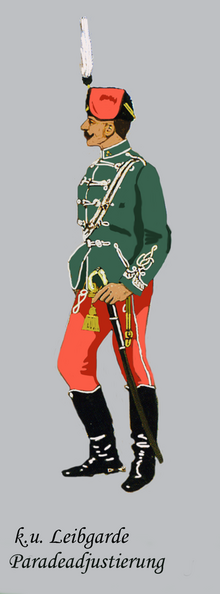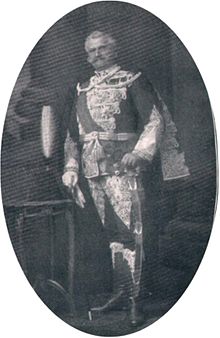Royal Hungarian Life Guard
The royal Hungarian bodyguard (ku bodyguard) was one of the five guard formations of the emperor of Austria , resp. in this capacity - the King of Hungary . Along with the Arcièren Life Guard, she was the most distinguished of the Guards and was on an equal footing with them.
The headquarters were at Hofstallstrasse 7 in Vienna, VII. District.
Command structure in August 1914
- Captain of the Guard: General of the Cavalry Albert Count Lónyayde Nagy-Lónya et Vásáros-Námény
- Lieutenant Guard: Lieutenant Field Marshal Anton Margrave Pallavicini
- Guard Lieutenant and Guard House Commander: Colonel Adalbert Spányik von Dömeháza
- Guard: Lieutenant Colonel Georg Gaisia - Major Eduard Schwarz - Major Eugen Freiherr von Geyso
history
With the founding diploma of September 11, 1760, this guard was founded under the original name of the Hungarian Noble Life Guard (also called the Hungarian Nobel Guard - praetoriana nobilis turma). It should not be more than 100-120 men and from the beginning it was under the jurisdiction of the Court War Council as a military corps .
The original task was the diplomatic courier service and the escort of Empress Maria-Theresa .
In 1810 the Hungarian Guard was re-formed with an increased number of personnel (183 men) after a continuing decline in personnel. The Guard, which had in fact not existed since the Hungarian Revolution, was disbanded on January 14, 1850. The ku bodyguard was re-established under this name with “handwriting sM from the emperor and king” of April 21, 1867 and existed until 1918.
The workforce was around 40 men. The Palais Trautson was assigned to her as barracks .
tasks
In Austria-Hungary the guard formations were not able to carry out acts of war; this in contrast to the more extensive guards in France (Empire), Great Britain or Germany . There were only five small units, of which only three could claim the term bodyguard and were company strength.
The ku bodyguard was an honor guard to which only deserving officers were called to accompany the king on festive occasions, whereby the protection of the king's person could not be in the foreground simply because of the sometimes old age of the guardsmen.
The tasks were of a purely representative nature. In matters relating to court service, she was subordinate to the First Colonel of all Guards (the tasks of a guard in the military sense in Austria-Hungary were incumbent on the kuk Leibgardereitereskadron and the kuk Leibgardeinfanteriekompanie , as well as to a limited extent the kuk Trabanten Bodyguard ).
Batches
The guard consisted only of generals, staff and senior officers with the following batch designation:
- Guard captain = higher general
- Guard captain lieutenant = higher general
- Lieutenant of the Guard = Field Marshal Lieutenant / Major General
- Guard Lieutenant = Major General / Colonel
- Guard sergeant = major
- Deputy Guard = Rittmeister 1st class
- Guard = Rittmeister / First Lieutenant
Adjustments
- Court service adjustment
-
- It comprised the following outfit for the captain and officers of the guard :
- Kalpak with heron bush, court service attila, court service fur , court service boot trousers, body belt, old Hungarian saber with court service saber dome and portepee , gloves, cycling coat, chisms ( hussar boots , yellow or black), command stick.
- For guard charges and garden:
- Parade adjustment
-
- It comprised the following outfit for the captain of the guard and the officers of the general rank:
- Kuchma (old Hungarian headgear) with heron bush, summer attila, winter attila, pantaloons , waist belt, ankle boots, coat, gloves, infantry officer's saber, saber dome, portepee, field bandage .
- For guard officers without general rank, guard charges and guards:
- Kuchma with heron bush, summer attila, winter attila, madder-red boot pants, cartridge, waist belt, cavalry officer's saber, saber dome, portepee, chisms.
Mount
- Headgear
- The Kalpak was worn as headgear with the court service uniform. He was equipped with a green cloth sack, as well as a white heron bush and polecat trimmings. On the right side was a golden braid of string. The heron bush had to be 38 cm high, the ostrich feathers covering the base, however, 7 cm.
The court service attila was made of crimson cloth and differed from that of a Hungarian general in that it was tied in silver. The captain of the guard wore three gold embroidered stars on his collar, the first lieutenant and lieutenant according to the distinction regulations. The vice-sergeants as Rittmeister and all subordinate ranks did not wear rank stars. Garden had a 2.6 cm wide silver border on the sleeve and collar. The guard batches in the position of vice-guard (as captain) have a 3.3 cm wide silver border on the collar and a similar 2.6 cm wide border on the sleeves. The guard vice sergeant (as a major) and the guard sergeant both had braids 3.3 cm wide.
The guard station fur was also made of crimson cloth and equipped with polecat trims. The court service trousers consisted of red cloth and were decorated with silver braids and silver lacing, the richness of the decoration increasing with the rank of rank.
The saber as a sidearm was made according to the old Hungarian model. The blade was about 70 cm long, 4 cm wide, ground on both sides with a hollow grind. The scabbard was made of black leather with three silver fittings that had radial notches converging in a circle. The dome of the court service was made of green saffiano leather with silver braid and silver buckles. The bike coat was cut round and equipped with red parolis . The waist belt was made of silver and green silk cords. A 90 cm long black ebony stick was also part of the court service (but only on foot) as a command stick .
The panther fur worn by the guards and guards was edged with a 3.3 cm wide trimming, which consisted of equilateral triangles. The fur had a green silk lining, the panther eyes were made of glass, teeth and paws were made of silver. The right back paw had an oval, silver shield on the outer side of which there was a raised double-headed eagle with the Hungarian coat of arms.
Guard charges and garden were identified by a cartridge . In shape and size, it resembled the cavalry officer's cartridge pouch, but was lined with green velvet. The side walls and the floor were made of wood, covered with silver and fitted with gold-plated brackets and hooks. A gilded imperial double-headed eagle with the Hungarian coat of arms made of gilded bronze was attached to the silver cartridge lid with a border . The cartridge was carried by a leather strap, which was covered with green velvet and decorated on the outside with a 5 cm wide silver border. This border had a strip of green silk in the middle.
A kuchma made of black fur with a madder red cloth sack and golden cord decoration (similar to the shako of the hussar officers) and a heron bush was worn with the parade uniform . The summer attila consisted of steel-green cloth in the cut and shape as for hussar officers, with cords and rosettes made of silver and white metal olives. The sleeves of the garden below the Vitéz Kötés were equipped with 3.3 cm wide silver braids; they wore gold stars on their collars. The staff officers corresponded to the staff officers of the hussars. The winter attila was also made of steel-green cloth and corresponded in cut and shape to those of the hussar officers, but with white metal olives, as well as silver cords and rosettes. Where available, the silver braids corresponded to those of the summer attila. The madder red breeches were those of the hussar officers with silver lacing. The footwear consisted of black chisms (hussar boots).
In addition, there was the field cap with white buttons and general design, as well as the coat corresponding to that of the generals in Hungarian uniform ; but with white buttons. This was worn for the initial adjustment.
Museum reception

The very glamorous and correspondingly complex adjustments of the guards are exhibited in the Army History Museum in Vienna. You can see outfits of the ku bodyguard, kk First Arcièren-Leibgarde , kuk Leibgardereitereskadron and the kuk Trabanten bodyguard .
Sources and literature
- Austrian State Archives / War Archives (Vienna)
- Oskar Brüch : The kuk Heer 1895. A series of images (= writings of the Heeresgeschichtliches Museum. Vol. 10). Commented by Günter Dirrheimer. Leopold Stocker Verlag, Graz u. a. 1997, ISBN 3-7020-0783-0 .
- Günter Dirrheimer (Ed.): The KK Army in the Biedermeier. New edition of the representation of the Imperial and Royal Austrian Army with all batches in 26 booklets. With an appendix of 20 sheets in folio. Contains the military music bands, artillery coverings, war navy and all the military train. Lithograph bey Joseph Trentsensky in Vienna, 1823. Edition Tusch, Vienna 1975, ISBN 3-85063-047-1 , (facsimile).
- Complete inventory of the Vienna House, Court and State Archives. Based on the history of the archive and its holdings. Volume 2: History and inventories of the archives of the House of Habsburg-Lothringen, the court staff and the cabinet archive (= inventories of the Viennese house, court and state archives 5. = inventories of Austrian state archives 5, 5). Holzhausen, Vienna 1937, p. 347 ff.
- Imperial and Royal War Ministry : Dislocation and division of the Imperial and Royal Army, the Imperial and Royal Navy, the Imperial and Royal Landwehr and the Imperial and Royal Landweh. In: Seidel's small army scheme. Seidel & Sohn, Vienna 1914, ( 1908 edition ; 81 kB.).
Web links
Footnotes and individual references
- ↑ However, writing of the kuk Militäradministratur to 1918 since the spelling reform of 1996 as Field Marshal Lieutenant referred
- ↑ His Majesty
- ↑ Johann Christoph Allmayer-Beck : The Army History Museum Vienna. Guide to the museum. Volume 1: The museum, the representation rooms. Kiesel, Salzburg 1981, ISBN 3-7023-0113-5 , p. 29.





